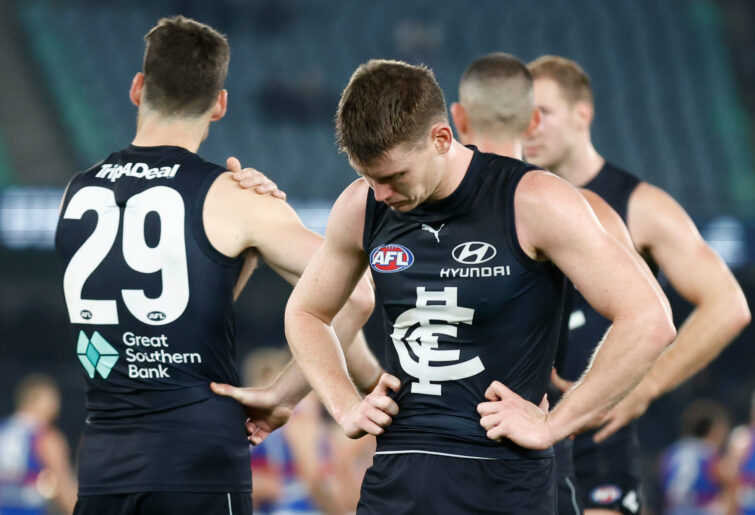Were the Cats dudded by crucial late non-advantage call in loss to Port?
Luke Hodge was adamant the right decision was made to call play back - but Cats fans disagreed!
Opinion
The AFL under Gillon McLachlan has made equalisation a key competition pillar. As the AFL strives to be a truly national sport, it continues to utilise several equalisation measures throughout the footy landscape.
These measures include salary caps on playing lists, the annual AFL draft based on the previous year’s ladder position, free agency trading and football department soft cap limits.
The AFL also has the authority to provide priority draft picks to struggling clubs and has historically utilised cost of living allowances for the New South Wales-based clubs. The AFL is also contemplating the introduction of a mid-season draft to help clubs hit by injuries or retirements throughout an individual season.
The AFL’s equalisation mandate has been on the most part successful. Since 2000, eleven individual clubs have won premierships, while another four clubs (St. Kilda, Fremantle, Adelaide and GWS) have made grand finals. Only three of the current 18 clubs (Gold Coast, Carlton and North Melbourne) have not qualified for a grand final since 2000.
Equalisation has also ensured that the game maintains relevance in New South Wales and Queensland as the AFL continually battles for market dominance against the NRL.
A major impediment to the equality and integrity of the AFL is the current fixturing system. This system has each AFL team playing 23 matches across an individual season. Each team plays 11 opposition clubs once a season and six opposition clubs twice a season.
Prior to the 2023 season, Travis Auld and his fixturing team at AFL house used a ‘weighted rule’ system to determine which clubs plays each other twice.
The 18 teams were broken into three groups: the top six teams from the previous year’s ladder, the middle six and bottom six.
The “double-up” fixtures a club is allocated each season has an unfair impact on ladder positions at the end of each season. This is particularly relevant this season, as three AFL clubs are non-competitive.
At Round 9, North Melbourne (two wins, 62.9%) West Coast (one win, 60.5%) and Hawthorn 60.0% (one win, 60.0%) provide easy wins for all other AFL teams.
Fortunately, no team plays all three of these teams twice in the 2023 season. However, this fixturing anomaly provides significant advantages for five clubs in particular. Melbourne, Fremantle, St Kilda, Essendon, North Melbourne will play two of these bottom three teams twice.
This will amount to an additional eight points and a significant percentage boost when compared to the five teams that do not play any of these bottom three teams twice (Geelong, Sydney, Collingwood, Brisbane, and Port Adelaide).
How much difference can these two extra wins make? A massive one. Fixturing inconsistencies can be the difference between finishing in the top four or qualifying for finals.
Last season, the difference between second-placed Melbourne (64 points) and sixth-placed Brisbane (60 points) was one win. The difference between the eighth-placed Bulldogs (48 points) and 12th-placed Gold Coast (40 points) was two wins.
Ninth-placed Carlton (48 points) missed the finals by 0.6% compared to the eighth-placed Bulldogs. The integrity of the season is therefore significantly impacted by these “double-up” fixtures.

Sam Walsh of the Blues looks dejected. (Photo by Michael Willson/AFL Photos via Getty Images)
How does the AFL fix this problem? The fairest solution would be to play a 34-game season where each team plays each other home and away. Unfortunately, the AFLPA and Cricket Australia would not allow this to occur due to the risks of injury and stadia availability.
Another fair alternative would be for each team to play each other once a season. Unfortunately, a 17-game season is not financially feasible for the AFL coffers and for TV rights negotiations.
So, what is a suitable fixturing approach for the current 23 game season? Instead of deciding on the double-up fixtures in the pre-season, the AFL should decide on the double-up fixtures in June or July of each year.
The AFL should then fixture the double-up fixtures from rounds 18-23. Each team should play two bottom six teams, two middle six teams and two top six teams from the current year in the final six rounds.
This delayed double-up fixturing would be fairer and mean that the ladder is already shaped up prior to the AFL determining which “double-up” fixture each team receives.
Until this occurs, the AFL will continue to have a lopsided draw without integrity or fairness.